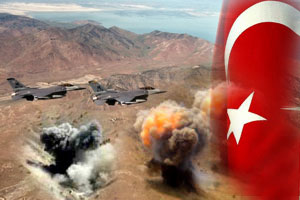 AMED, — A delegation of IHD (Human Rights Association) and BDP (Peace and Democracy Party) members are going to Geliye Tiyare to investigate the allegations that the Turkish army have used chemical weapons against the Kurdish guerrillas in the recent offensives, ANF reports.
AMED, — A delegation of IHD (Human Rights Association) and BDP (Peace and Democracy Party) members are going to Geliye Tiyare to investigate the allegations that the Turkish army have used chemical weapons against the Kurdish guerrillas in the recent offensives, ANF reports.
It has been confirmed that as many as 35 Kurdish guerrillas have lost their life in the operation carried out by the Turkish Armed Forces between 22-24 October.
Twenty-four bodies are held at Malatya Forensic Institute’s morgue. Families and IHD officials who have seen the bodies have confirmed that they were torn to pieces and had burns all over, signs which indicates the use of some chemicals.
The Turkish Army is not new to the use of chemical weapons. Indeed in August this year the IHD Amed (Diyarbakir) branch had published a detailed report on the use of chemical weapons.
According to that report 437 guerrillas have lost their lives in 39 separate operations carried out with chemical weapons by the Turkish army since 1994.
The IHD “Report of Chemical Weapons” contains important information about the Turkish army operations in which chemical weapons have been used.
The report reminded that the allegation concerning the use of chemical weapons has been frequently brought to the agenda since the 1990s also gave examples from the military operations where chemical weapons were used.
The report states for example that 20 PKK guerrillas, who lost their lives in the operation near Bilika village in Silopi district of Şırnak on May 11, 1999, were said to have been killed with chemical weapons.
A chemical gas tube, claimed to have been used in the operation and found at the scene, was sent to Germany for a criminal investigation. The report issued after the investigation in the criminal laboratory in Germany concluded that the material (the tube) was of a deadly chemical gas containing chemicals.
8 PKK guerrillas including two women, who lost their lives in a clash in September 2009 Cukurca district of Hakkari, were killed by chemical weapons. Upon finding some photos and materials verifying the assertion, human rights organizations sent the materials to Germany for an investigation after which the German press wrote that the Turkish army used ‘chemical weapons’ against PKK militants.
While German human rights activists and politicians demanded an international investigation into the issue, the University of Hamburg issued a report and proved the use of chemical weapons by the TSK (Turkish Armed Forces).
Separately, expert Hans Baumann who examined the photos of the event proved that the photos were real images, while Hamburg University Hospital issued a report saying that the guerrillas were most likely killed with chemical weapons.
PKK guerrilla Bedran Kaya, who lost his life in the clash in Hakkari’s Semdinli district on July 31, 2011, was as well claimed to have been killed with a chemical weapon. The assertion came up upon the notification of those seeing Kaya’s body which had no bullet marks but an intense skin eruption.
Zafer Tanriş who appealed to our branch on 29 April 2009 made the following statement; ‘‘my brother Gokmen Tanriş left home about 16 years ago and we have not heard from him since then. After some time we received unconfirmed information that he had joined the PKK. In addition, we did not have any information on whether he was alive or not. However, 10 days ago we learned that my brother had been killed in a clash where chemical weapons were used in Samsavat region between Erzincan and Gumuşhane provinces in 1994. We want to reclaim his body and to find out if he was killed with a chemical weapon or not. I demand you to make the necessary attempts for the identification and reclamation of his body.’
22 students, who left Malatya to join the PKK but were slaughtered in mass on May 17, 1994 at the Bezar Mountain in Adıyaman yet before reaching the guerrilla area, and six PKK militants, who came to the area to meet the students, were also claimed to have been killed with chemical weapons.
While few eye-witnesses confirmed the use of chemical weapons during the operation, journalist Evrim Alataş called attention to the use of chemical weapons in a review she wrote about Fidel Tore who was among these 22 students.
The bodies of 21 PKK guerrillas, who were claimed to have been killed with chemical weapons in a clash in Çemişgezek district of Dersim on 11 April 1997, have still not been delivered to their families although their code names and birth places are already registered at the Office of Malatya Special Authority Chief Prosecutor.”